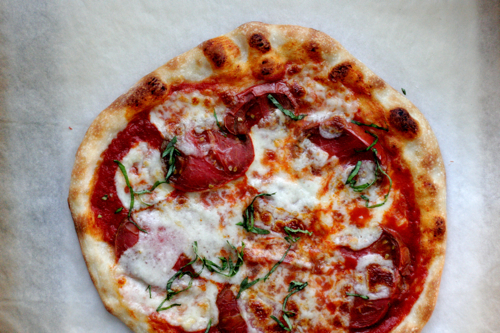

Phase 1: Pizza for Beginners. It started with a pizza stone. My mom bought us one for Christmas two years ago, and since then I've gone through several recipes on a passionate search for the ultimate pizza. But I didn't start out this obsessed. I made the first of many pizzas using the perfectly acceptable fresh dough from Trader Joe's, topping pie's with pesto and tomatoes, and shredded mozzarella. The crust, thanks to our stone, was crisp, and at the time it was everything we hoped for from a standard home oven. Then the dough experiments began.
Phase 2: Instant Gratification. My dilemma was that I wanted pizza on a weeknight, but I didn't want to wait hours for the dough to rise. Enter: Rapid Rise Yeast and 20 Minute Pizza Dough. A little mixing, and twenty minutes of resting later, homemade dough was ready to bake.




Phase 3: We're getting warmer. The dough started tasting better when I tried a recipe from Giada de Laurentiis. It was a more traditional route, using active dry yeast and allowing the dough to double in size, about an hour. The longer rise offered extra time for the yeast to do its work and impart more flavor into the dough. Fine, I thought. It might actually be worth it to wait.
Phase 4: Pizza Nirvana. Many fellow bloggers have posted about the wonder that is Peter Reinhart's pizza dough, and I'm ecstatic that I finally tried it. The dough rests in the refrigerator overnight, and then on the counter for two hours before baking, so you need to work this into your schedule. But the upside is that you can make the dough ahead of time, freeze it, and pull it the day you plan to use it. The dough is soft, and tastes the closest to restaurant-quality pizza (ie: Pizzeria Mozza) I've had in my own kitchen. This dough is very, very special, and I can confidently say that my search for the best pizza dough is over. I might be tempted to try another recipe down the road, just for the sake of curiosity, but when it comes to thin crust pizza, this is where the search ends and great pizza making begins.
 Preheat Your Oven. Restaurant pizza ovens can reach temperatures upwards of 800 degrees. Since most home ovens don't even come close, there are a few steps you can take to help ensure your pizza will be at its best. Preheat your oven for at least 45 minutes to one hour, at 475 or 500 degrees, with the pizza stone inside. It sounds like a lot of time, but your pizza will be crisper for it. If you're skeptical, just try it once, as an experiment, and you'll see what I mean.
Preheat Your Oven. Restaurant pizza ovens can reach temperatures upwards of 800 degrees. Since most home ovens don't even come close, there are a few steps you can take to help ensure your pizza will be at its best. Preheat your oven for at least 45 minutes to one hour, at 475 or 500 degrees, with the pizza stone inside. It sounds like a lot of time, but your pizza will be crisper for it. If you're skeptical, just try it once, as an experiment, and you'll see what I mean.
The Pizza Stone. To achieve a crisp crust, you need a stone. Period.
 Toppings. If you're making thin crust pizzas, don't weigh them down with too many toppings. Keep sauce to a minimum and vegetables thinly sliced. You'll be surprised how a little really goes a long way.
Toppings. If you're making thin crust pizzas, don't weigh them down with too many toppings. Keep sauce to a minimum and vegetables thinly sliced. You'll be surprised how a little really goes a long way.
 Parchment Paper vs. Pizza Peel. There are several tecniques for transfering your pizza to the baking stone. Some rely on parchment paper, placing toppings ahead of time, then placing the pizza (with parchment) directly on the stone. The paper doesn't burn in the oven, but the dough won't crisp up as much. You can pull the parchment out half way through cooking, but why disturb your pizza?
Parchment Paper vs. Pizza Peel. There are several tecniques for transfering your pizza to the baking stone. Some rely on parchment paper, placing toppings ahead of time, then placing the pizza (with parchment) directly on the stone. The paper doesn't burn in the oven, but the dough won't crisp up as much. You can pull the parchment out half way through cooking, but why disturb your pizza?
With a pizza peel, the same method applies where you prepare the pizza on the peel, then gently slide it onto the stone. With a generous amount of cornmeal, this method is straightforward, but I don't need another piece of equipment.
Here's my method: On a floured cutting board, shape your dough. After the pre heating step, pull the stone out of the oven, sprinkle a little cornmeal down, and place the dough directly onto the stone. Then, proceed to add your toppings. The crust will begin cooking immediately, even while you're sprinkling on the cheese.
Rolling pin vs. hand tossing. Find what works for you and the space you have to work with. In my experience, the thicker doughs (ie: the 20 minute dough and 1-hour dough recipes) were easier to work with using a rolling pin. I also made one large pizza with the entire dough, which is more challenging to shape by hand. For Peter Reinhart's recipe, the pizzas are smaller and the dough is infinitely softer, making it very easy to press out with your hands. When it comes to tossing, handle at your own risk! It's fun to try, and even more fun to pick it up off the ground when you've dropped it or hooked it onto the light fixture. Just start practicing and you'll find your comfort zone.
Practice patience. Not for too long, but give your pizza a minute to cool down. I say this to prevent you from burning your tongue, as I have on more than one occasion.
PETER REINHART'S PIZZA DOUGH
Recipe from The Bread Baker's Apprentice by Peter Reinhart, via 101 Cookbooks, and adapted slightly with my own notes.
Makes 6 six-ounce pizza crusts
Ingredients
4 1/2 cups (20.25 ounces) unbleached high-gluten, bread, or all-purpose flour, chilled
1 3/4 (.44 ounce) teaspoons salt
1 teaspoon (.11 ounce) instant yeast
1/4 cup (2 ounces) olive oil
1 3/4 cups (14 ounces) water, ice cold (40°F)
Cornmeal for dusting
Directions
1. In the bowl of an electric mixer, stir together the flour, salt and instant yeast using the paddle attachment. Drizzle in the oil, and the cold water until all the flour is absorbed. Switch to the dough hook and mix on medium speed for 5 to 7 minutes, or as long as it takes to create a smooth, sticky dough. The dough should clear the sides of the bowl but stick to the bottom of the bowl. If the dough is too wet and doesn't come off the sides of the bowl, sprinkle in some more flour just until it clears the sides. If it clears the bottom of the bowl, dribble in a tea- spoon or two of cold water. The finished dough will be springy, elastic, and sticky, not just tacky, and register 50 to 55F.
2. Sprinkle flour on a cutting board or counter and turn out the dough. Prepare a glass baking dish by lining it with parchment paper and misting the parchment with spray oil. (I've forgotten to do this, and as long as the baking dish is well oiled, you shouldn't have trouble.) Using a metal dough scraper or sharp knife, cut the dough into 6 equal pieces. Sprinkle flour over the dough. Make sure your hands are dry and then flour them. Lift each piece and gently round it into a ball. If the dough sticks to your hands, dip your hands into the flour again. Transfer the dough balls to the baking dish. Mist the dough generously with spray oil or slather them with olive oil. Cover the dough with plastic wrap and put into the refrigerator overnight to rest the dough, or keep for up to 3 days.
DO-AHEAD: If you want to freeze dough for later use, this is the time. After shaping, dough can be stored in individual zippered freezer bags. Pour some oil into each bag, then turn the dough to coat it well. Seal the bag, and place into the freezer for up to 3 months. Transfer them to the refrigerator the day before you plan to make pizza.
3. On the day you plan to make the pizza, remove the desired number of dough balls from the refrigerator 2 hours before making the pizza. Before letting the dough rest at room temperature for 2 hours, dust the counter with flour, and then mist the counter with spray oil. Place the dough balls on top of the floured counter and sprinkle them with flour; dust your hands with flour. Gently press the dough into flat disks about 1/2 inch thick and 5 inches in diameter. Sprinkle the dough with flour, mist it again with spray oil, and cover the dough loosely with plastic wrap or a food-grade plastic bag. Now let rest for 2 hours.
4. At least 45 minutes before making the pizza, place a baking stone either on the floor of the oven (for gas ovens), or on a rack in the lower third of the oven. Heat the oven as hot as possible.
5. Make the pizzas one at a time. Dip your hands, including the backs of your hands and knuckles, in flour and lift I piece of dough by getting under it with a pastry scraper. Very gently lay the dough across your fists and carefully stretch it by bouncing the dough in a circular motion on your hands, carefully giving it a little stretch with each bounce. If it begins to stick to your hands, lay it down on the floured counter and reflour your hands, then continue shaping it. If you have trouble tossing the dough, or if the dough keeps springing back, let it rest for 5 to 20 minutes so the gluten can relax, and try again. You can also resort to using a rolling pin, though this isn't as effective as the toss method. (Practice, practice, practice!)
6. When the dough is stretched out to your satisfaction (about 9 to 10 inches), remove the baking stone and dust with cornmeal (or lay it on the peel, if using, making sure there is enough cornmeal for it to slide.) Lightly top it with sauce and then with your other toppings, remembering that the best pizzas are topped with a less-is-more philosophy. The American "kitchen sink" approach is counterproductive, as it makes the crust more difficult to bake. A few, usually no more than 3 or 4 toppings, including sauce and cheese is sufficient.
7. Slide the stone with topped pizza back into the oven (or slide it from your peel to the stone) and close the door. Wait 2 minutes, then take a peek. If it needs to be rotated 180 degrees for even baking, do so. The pizza should take about 5 to 8 minutes to bake (This will vary widely with each oven, so watch it carefully). If the top gets done before the bottom, you will need to move the stone to a lower self before the next round. if the bottom crisps before the cheese caramelizes, then you will need to raise the stone for subsequent bakes.
8. Remove the pizza from the oven and transfer to a cutting board. Wait 3 to 5 minutes before slicing and serving, to allow the cheese to set slightly.

